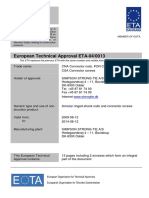Forming Process Report
Uploaded by
Aqib ZamanForming Process Report
Uploaded by
Aqib ZamanForming (metalworking)
Forming,metal forming, is the metalworking process of fashioning metal parts and objects through
mechanical deformation; the workpiece is reshaped without adding or removing material, and its
mass remains unchanged.[1] Forming operates on the materials science principle of plastic
deformation, where the physical shape of a material is permanently deformed.
Characteristics
Metal forming tends to have more uniform characteristics across its subprocesses than its
contemporary processes, cutting and joining.
On the industrial scale, forming is characterized by: [2]
Very high loads and stresses required, between 50 and 2500 N/mm2 (7-360 ksi)
Large, heavy, and expensive machinery in order to accommodate such high stresses and
loads
Production runs with many parts, to maximize the economy of production and compensate
for the expense of the machine tools
Forming processes
Forming processes are particular manufacturing processes which make use of suitable stresses
(like compression, tension, shear or combined stresses) to cause plastic deformation of the
materials to produce required shapes.
During forming processes no material is removed, i.e. they are deformed and displaced.
Forming processes tend to be categorised by differences in effective stresses. These categories and
descriptions are highly simplified, since the stresses operating at a local level in any given process
are very complex and may involve many varieties of stresses operating simultaneously, or it may
involve stresses which change over the course of the operation.
Compressive forming involves those processes where the primary means of plastic deformation is
uni- or multiaxial compressive loading.
Rolling, where the material is passed through a pair of rollers
Extrusion, where the material is pushed through an orifice
Die forming, where the material is stamped by a press around or onto a die
Forging, where the material is shaped by localized compressive forces
Indenting, where a tool is pressed into the workpiece
Tensile forming[edit]
Tensile forming involves those processes where the primary means of plastic deformation is uni- or
multiaxial tensile stress.
Stretching, where a tensile load is applied along the longitudinal axis of the workpiece
Expanding, where the circumference of a hollow body is increased by tangential loading
Recessing, where depressions and holes are formed through tensile loading
Combined tensile and compressive forming[edit]
This category of forming processes involves those operations where the primary means of plastic
deformation involves both tensile stresses and compressive loads.
Pulling through a die
Deep drawing
Spinning
Flange forming
Upset bulging
Bending[edit]
Main article: Bending (metalworking)
This category of forming processes involves those operations where the primary means of plastic
deformation is a bending load.
Shearing[edit]
Main article: Shear forming
This category of forming processes involves those operations where the primary means of plastic
deformation is a shearing load.
Some of example of forming processes are:
Forging
Extrusion
Rolling
Sheet metal working
Rotary swaging
Thread rolling
Explosive forming
Electromagnetic forming
Metal forming is a manufacturing process in which forces are applied on raw material such
that stresses induced in the material are greater than yield stress and less than ultimate
stress.
The material experiences plastic deformation to change the shape of the component and
converted to the desired shape of the component.
Forming process can be broadly classified into two types as cold working and hot working.
1. Cold Working:
Deforming the material at a temperature below the recrystallization temperature of the work
metal is called cold working. In cold working process, strength and hardness increases due
strain hardening, but ductility decreases. Good surface finish and high dimensional
accuracy are achieved. If cold working is higher than certain limits, the metal will fracture
before reaching the desired shape and size. Usually cold working operations are performed
in many steps with intermediate annealing operation.
2. Hot Working:
Deforming the material at a temperature higher or equal to the recrystallization temperature
of the work metal is called hot working. In hot working, refinement of grain size occurs, thus,
improving mechanical properties. Even a brittle material can be hot worked. This requires
much less force for deformation, but the finally formed surface finish and dimensional
accuracy are not good. There is no work hardening.
Advantages:
The amount of wastage of metal during metal forming process is negligible.
Grain orientation is possible.
Because of grain orientation the material is converted from isotropic to anisotropic
material.
In most of engineering applications it requires anisotropic material.
Sometimes the strength and hardness of work material is increasing.
Some other metal forming process, the surface finish obtained on the component is
very good and excellent.
Disadvantages:
Higher mount of force and energy is required for metal forming process compared to
other manufacturing methods.
Except the forging operation, all other metal forming process are used for producing
uniform cross sectioned components only.
The components with cross holes cannot be produced easily using metal forming
process.
You might also like
- The Essentials of Material Science and Technology for EngineersFrom EverandThe Essentials of Material Science and Technology for Engineers5/5 (1)
- Apznzaahwcyjobv8rtgat9nqq0bftjze2sk5rfnktiwq0zwv2gu1l5x31qaxvpuw9urxlwd1up6 Wasbeb4-Hnhibhf3pemc Crk7z6qkqxj8jdc9muje3p Nyrrq0pebm7cnvc4im5c3d94kmjdoizlapcjo-Igb2vekm3hpsdix 22apg5yuv4lxjojauxseg6b3hfhbmgtv59gjs0plNo ratings yetApznzaahwcyjobv8rtgat9nqq0bftjze2sk5rfnktiwq0zwv2gu1l5x31qaxvpuw9urxlwd1up6 Wasbeb4-Hnhibhf3pemc Crk7z6qkqxj8jdc9muje3p Nyrrq0pebm7cnvc4im5c3d94kmjdoizlapcjo-Igb2vekm3hpsdix 22apg5yuv4lxjojauxseg6b3hfhbmgtv59gjs0pl36 pages
- Short Notes of Manufacturing Processes Lyst9378No ratings yetShort Notes of Manufacturing Processes Lyst937818 pages
- Plastic Deformation Tool Die Yield STR Ength Geometry of The Die. Stresses Applied Co Mpressive Stretch Bend Shear StressesNo ratings yetPlastic Deformation Tool Die Yield STR Ength Geometry of The Die. Stresses Applied Co Mpressive Stretch Bend Shear Stresses102 pages
- Casting Forming Sheet Metal Processing Powder-And Ceramics Processing Plastics ProcessingNo ratings yetCasting Forming Sheet Metal Processing Powder-And Ceramics Processing Plastics Processing44 pages
- Bulk Deformatin Processes and EquipmentNo ratings yetBulk Deformatin Processes and Equipment46 pages
- Manufacturing Engineering Forming: Chapter 3: MetalNo ratings yetManufacturing Engineering Forming: Chapter 3: Metal98 pages
- Chapter 18-Fundamentals of Metal FormingNo ratings yetChapter 18-Fundamentals of Metal Forming33 pages
- Lecture 7 - Manufacturing Processes - Metal and Sheet Forming, Bulk Deformation Processes - DR Bilal Ahmad PDFNo ratings yetLecture 7 - Manufacturing Processes - Metal and Sheet Forming, Bulk Deformation Processes - DR Bilal Ahmad PDF62 pages
- 1-Basics and Classification of Metal FormingNo ratings yet1-Basics and Classification of Metal Forming17 pages
- 4-Rolling - Classification of Rolling Processes - Types of Rolling Mills - Expression For Rolling-14!08!2024No ratings yet4-Rolling - Classification of Rolling Processes - Types of Rolling Mills - Expression For Rolling-14!08!2024144 pages
- MANISH KUMAR ECEB 69 ASSINGMENT 2 MANUFACTURING PROCESSNo ratings yetMANISH KUMAR ECEB 69 ASSINGMENT 2 MANUFACTURING PROCESS7 pages
- MANISH KUMAR ECEB 69 ASSIGNMENT 2 MANUFACTURING PROCESSNo ratings yetMANISH KUMAR ECEB 69 ASSIGNMENT 2 MANUFACTURING PROCESS7 pages
- Metal Forming & Shaping Processes: Topic 3No ratings yetMetal Forming & Shaping Processes: Topic 337 pages
- Microsoft PowerPoint - 06_FUNDAMENTALS OF METAL FORMING_ch18No ratings yetMicrosoft PowerPoint - 06_FUNDAMENTALS OF METAL FORMING_ch1822 pages
- IPE 341-Metal Forming Processes - Bulk Deforamtion ProcessesNo ratings yetIPE 341-Metal Forming Processes - Bulk Deforamtion Processes79 pages
- Fundamentals of Metal Forming: Fig 1.1 Fig 1.2No ratings yetFundamentals of Metal Forming: Fig 1.1 Fig 1.254 pages
- Lab Session Operations of Lathe Machine Part 20% (1)Lab Session Operations of Lathe Machine Part 23 pages
- Lab Session Introduction To Lathe MachineNo ratings yetLab Session Introduction To Lathe Machine5 pages
- Lab Session Operations of Lathe Machine Part 1No ratings yetLab Session Operations of Lathe Machine Part 12 pages
- Timeline of Quality Methods (Montgomery) Introduction To Statistical Quality Control, 6th Edition100% (1)Timeline of Quality Methods (Montgomery) Introduction To Statistical Quality Control, 6th Edition2 pages
- All You Ever Need To Know Product-DevelopmentNo ratings yetAll You Ever Need To Know Product-Development81 pages
- A Case Study of Life Cycle Cost Based On A Real FRP BridgeNo ratings yetA Case Study of Life Cycle Cost Based On A Real FRP Bridge4 pages
- Aerated Autoclaved Concrete Aac Blocks NNo ratings yetAerated Autoclaved Concrete Aac Blocks N12 pages
- Is 10182 (Part 2) - 1985 Dimensions and Tolerances For Hot Rolled Track Shoe Sections - Part 2 Section Ts-h1No ratings yetIs 10182 (Part 2) - 1985 Dimensions and Tolerances For Hot Rolled Track Shoe Sections - Part 2 Section Ts-h112 pages
- ITL Public School: Class: X Subject: GeographyNo ratings yetITL Public School: Class: X Subject: Geography6 pages
- Supply Chain Efficiencies and Improvement InitiativesNo ratings yetSupply Chain Efficiencies and Improvement Initiatives43 pages
- Human Resource Management - I Prof. Kalyan Chakravarti Vinod Gupta School of Management Indian Institute of Technology, KharagpurNo ratings yetHuman Resource Management - I Prof. Kalyan Chakravarti Vinod Gupta School of Management Indian Institute of Technology, Kharagpur33 pages
- Eco-Sectors of The Indian Economy - Term1 - Class10No ratings yetEco-Sectors of The Indian Economy - Term1 - Class104 pages
- Analysis of Machine Hour Rate in The SupNo ratings yetAnalysis of Machine Hour Rate in The Sup50 pages
- Cold Forming Procedure of Single Piece 2:1 Ellipsoidal Dish EndNo ratings yetCold Forming Procedure of Single Piece 2:1 Ellipsoidal Dish End4 pages
- The Essentials of Material Science and Technology for EngineersFrom EverandThe Essentials of Material Science and Technology for Engineers
- Apznzaahwcyjobv8rtgat9nqq0bftjze2sk5rfnktiwq0zwv2gu1l5x31qaxvpuw9urxlwd1up6 Wasbeb4-Hnhibhf3pemc Crk7z6qkqxj8jdc9muje3p Nyrrq0pebm7cnvc4im5c3d94kmjdoizlapcjo-Igb2vekm3hpsdix 22apg5yuv4lxjojauxseg6b3hfhbmgtv59gjs0plApznzaahwcyjobv8rtgat9nqq0bftjze2sk5rfnktiwq0zwv2gu1l5x31qaxvpuw9urxlwd1up6 Wasbeb4-Hnhibhf3pemc Crk7z6qkqxj8jdc9muje3p Nyrrq0pebm7cnvc4im5c3d94kmjdoizlapcjo-Igb2vekm3hpsdix 22apg5yuv4lxjojauxseg6b3hfhbmgtv59gjs0pl
- Plastic Deformation Tool Die Yield STR Ength Geometry of The Die. Stresses Applied Co Mpressive Stretch Bend Shear StressesPlastic Deformation Tool Die Yield STR Ength Geometry of The Die. Stresses Applied Co Mpressive Stretch Bend Shear Stresses
- Casting Forming Sheet Metal Processing Powder-And Ceramics Processing Plastics ProcessingCasting Forming Sheet Metal Processing Powder-And Ceramics Processing Plastics Processing
- Manufacturing Engineering Forming: Chapter 3: MetalManufacturing Engineering Forming: Chapter 3: Metal
- Lecture 7 - Manufacturing Processes - Metal and Sheet Forming, Bulk Deformation Processes - DR Bilal Ahmad PDFLecture 7 - Manufacturing Processes - Metal and Sheet Forming, Bulk Deformation Processes - DR Bilal Ahmad PDF
- 4-Rolling - Classification of Rolling Processes - Types of Rolling Mills - Expression For Rolling-14!08!20244-Rolling - Classification of Rolling Processes - Types of Rolling Mills - Expression For Rolling-14!08!2024
- MANISH KUMAR ECEB 69 ASSINGMENT 2 MANUFACTURING PROCESSMANISH KUMAR ECEB 69 ASSINGMENT 2 MANUFACTURING PROCESS
- MANISH KUMAR ECEB 69 ASSIGNMENT 2 MANUFACTURING PROCESSMANISH KUMAR ECEB 69 ASSIGNMENT 2 MANUFACTURING PROCESS
- Microsoft PowerPoint - 06_FUNDAMENTALS OF METAL FORMING_ch18Microsoft PowerPoint - 06_FUNDAMENTALS OF METAL FORMING_ch18
- IPE 341-Metal Forming Processes - Bulk Deforamtion ProcessesIPE 341-Metal Forming Processes - Bulk Deforamtion Processes
- Timeline of Quality Methods (Montgomery) Introduction To Statistical Quality Control, 6th EditionTimeline of Quality Methods (Montgomery) Introduction To Statistical Quality Control, 6th Edition
- A Case Study of Life Cycle Cost Based On A Real FRP BridgeA Case Study of Life Cycle Cost Based On A Real FRP Bridge
- Is 10182 (Part 2) - 1985 Dimensions and Tolerances For Hot Rolled Track Shoe Sections - Part 2 Section Ts-h1Is 10182 (Part 2) - 1985 Dimensions and Tolerances For Hot Rolled Track Shoe Sections - Part 2 Section Ts-h1
- Supply Chain Efficiencies and Improvement InitiativesSupply Chain Efficiencies and Improvement Initiatives
- Human Resource Management - I Prof. Kalyan Chakravarti Vinod Gupta School of Management Indian Institute of Technology, KharagpurHuman Resource Management - I Prof. Kalyan Chakravarti Vinod Gupta School of Management Indian Institute of Technology, Kharagpur
- Eco-Sectors of The Indian Economy - Term1 - Class10Eco-Sectors of The Indian Economy - Term1 - Class10
- Cold Forming Procedure of Single Piece 2:1 Ellipsoidal Dish EndCold Forming Procedure of Single Piece 2:1 Ellipsoidal Dish End































































































